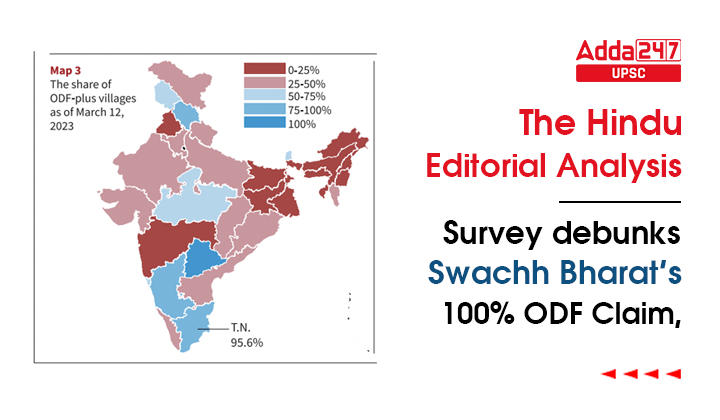Table of Contents
Swachh Bharat’s ODF claim: Open Defecation-Free (ODF) certificate is given by the government under Swachh Bharat Mission (SBM) to villages which have completely eliminated the practice of open defection in the village. Survey debunks Swachh Bharat’s 100% ODF claim is a The Hindu Editorial and Important for UPSC Prelims 2023 and UPSC Mains Exam (GS Paper 2- Various Policies and Programs of the government to ensure cleanliness and healthy living in the country).
Swachh Bharat’s ODF claim in News
A recently released government survey has called into question the Central government’s claim in 2019 that all Indian villages are open defecation-free (ODF). However, four government surveys/reports released just before or after the announcement, including the latest Multiple Indicator Survey (MIS), have not only disputed the ODF status of most States but also shown persisting levels of poor sanitation in many of them.
Various Surveys on ODF Status
The three older surveys have disputed the 100% ODF status suggested by the government. They were the National Statistical Office (NSO) survey from October 2018, the National Annual Rural Sanitation Survey (NARSS) of 2019-20, and the National Family Health Survey-5 (NFHS-5) 2019-21. So various surveys and studies have reported contradictory results showing that ODF status may not have been achieved in reality.
Swachh Bharat Mission, Gramin (SBMG) Survey
According to data from the Swachh Bharat Mission, Gramin (SBMG) portal, villages in Madhya Pradesh and Tamil Nadu were declared 100% ODF by October 2018.
- The SBMG data claimed that in 24 States/UTs, over 99% of rural households had individual household latrine as of March 2019, whereas the NARSS data recorded six months later showed that in 24 States/UTs, less than 90% of the rural households had access to their own toilets.
- According to the SBMG data, 99.4% of rural households in Gujarat had individual latrines as of March 2019.
NFHS Data and NSO Survey
According to NSO data, only 71% and 62.8% of rural households in Madhya Pradesh and Tamil Nadu, respectively, had access to some form of latrine (own, shared, public) in the same month.
- However, according to NFHS data, in the second half of 2019, only 63.3% of the population in rural households in Gujarat used individual toilets.
Multiple Indicator Survey (MIS) (Latest)
According to the MIS released in March 2022, conducted between January 2020 and August 2021, in 21.3% of rural households, a majority said they had no access to any type of latrine (own, shared, public).
- The MIS survey is the fourth in the last five years to debunk the ODF claim.
- A majority of the members in rural households reported access to some type of latrine, as per the MIS survey. For instance in Kerala, 100% said they had access, while in Uttar Pradesh only 74.2% had such access.
Concerns with Premature 100% ODF Certificates
While the goal of Swachh Bharat Gramin phase-1 were yet to be achieved, the government unveiled phase-2.
- The phase-2 extended toilet coverage to schools/anganwadis. It also maintains that all villages should have solid/liquid waste management systems.
- The villages which met these criteria were named ODF-plus villages.
- Due to the clubbing of goals, the share of rural households with toilet access (the goal of phase-1) was not tracked separately any more.
- Also, phase-1 related indicators were removed from the dashboard.
- As of April 1, 2022, Overall in India, only 8% of villages attained this ODF-plus status. Tamil Nadu’s share was over 91%.
- Interestingly, just a year ago, according to the MIS survey, only 72.4% of rural households in Tamil Nadu had access to some form of toilet.
- The share of ODF-plus villages in India improved to 34% as of March 12, 2023.
- While the SBMG dashboard does not track toilet access separately, the Swachh Survekshan Grameen survey (December 2021-April 2022) lists the percentage of households with access to toilets.
- It concluded that in 28 States, the share of such households crossed 90% and India’s average was 95%, wildly different from the figures of the MIS survey completed six months earlier.
Conclusion
Having right date about the status of faulty sanitation practices is key to implementing the right policies in true spirit and end the practice of open defecation from India.
Swachh Bharat Mission Urban 2.0: Revised Swachh Certification Protocols Launched
Swachh Bharat Mission Urban 2.0: Revised Swachh Certification Protocols Launched



 TSPSC Group 1 Question Paper 2024, Downl...
TSPSC Group 1 Question Paper 2024, Downl...
 TSPSC Group 1 Answer key 2024 Out, Downl...
TSPSC Group 1 Answer key 2024 Out, Downl...
 UPSC Prelims 2024 Question Paper, Downlo...
UPSC Prelims 2024 Question Paper, Downlo...
